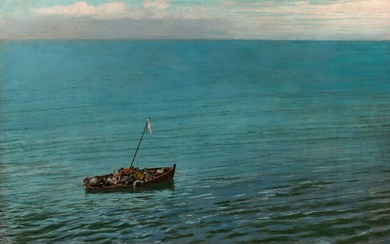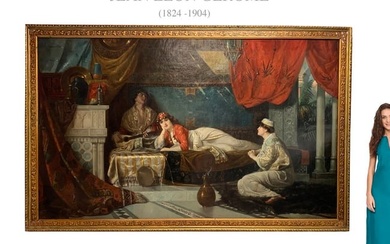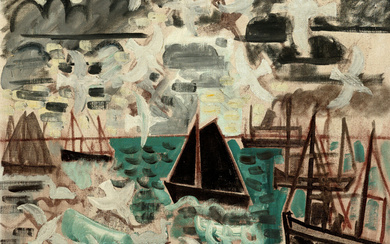Jean-Léon Gérôme Arnaut at Rest
Property from a Private Collection
Jean-Léon Gérôme
French
1824 - 1904
Arnaut at Rest
signed J.L. GEROME to the wall upper left
oil on panel
Unframed: 35.5 by 25cm., 14 by 9¾in.
Framed: 55.5 by 45.2cm., 21¾ by 17¾in.
Condition Report:
The panel is straight and even and providing a strong support to the paint surface. The work is in excellent condition and ready to hang. There is some very faint craquelure to the small sections of blue sky. Inspection under ultraviolet light reveals a layer of varnish making the surface difficult to read, however with the exception of some small old retouches to the left lower edge and the lower right edge (presumably from frame contact), there appears to be no other restoration.
Catalogue Note:
Gérôme’s Arnaut at Rest is a masterful representation of a subject – that of the Arnaut, or bashi-bazouk - that fascinated Gérôme and which he explored in numerous compositions. Seated in a shady Cairo interior, a lone Arnaut enjoys a moment of rest from duty to smoke an Ottoman huqqa, or narguile, through a snaking mouthpiece. Beside him, a mother-of-pearl inlaid gueridon table, rests a half-drunk glass of tea. Of note are the figure’s distinctive white pleated kilt, depicted with expert handling of light and shadow as hundreds of knife edge pleats cascade over the seated man’s crossed legs. Equally skillful is Gérôme’s handling of the other fabrics, including the silk shirt with its subtle sheen where it has caught the light, and of the magnificent Cairene mashrabiye lattice-work window overlooking the sun-drenched street below.
Arnauts were irregular soldiers in the Ottoman army and hailed from Albania and the Balkans. They were deployed across the Empire, but mainly in Cairo and Egypt. The strain on the Ottoman feudal system caused by the Empire's wide expanse required heavier reliance on these irregular soldiers, who were armed and maintained by the government. These soldiers neither received pay nor wore uniforms and distinctive badges. Because they were not formally trained, they could not serve in major military operations; however, they were useful for other tasks, such as reconnaissance and outpost duty. The Arnauts were deployed across the Empire, including in Cairo, where Gérôme would have encountered them from the day he first set foot in Egypt in 1856. Proud of their Balkan heritage, they always retained their distinctive costume. As irregulars, they were at liberty to supplement their income by other means, whether as guards, animal handlers, or modelling for travelling artists.
Gérôme at times painted Arnauts relaxing, dancing, merry-making, playing chess or music, for example in Café House, Cairo (Casting Bullets). However, in a different vein he also depicted them as figures for Ottoman authority, as in Egyptian Recruits Crossing the Desert (1857), in which Arnauts lead forced conscripts on their march; or to represent Muslim piety as in Prayer in the House of an Arnaut Chief. The conception of Gérôme’s paintings of bashi-bazouks was based not only on his usual sketches but also on photographs he had taken with Auguste Bartholdi in 1856. A photograph from the Gérôme/Morot Collection at the Musée d’Orsay shows a male model posing in Arnaut dress which was no doubt crucial in helping Gérôme capture the patterns of light and shadow on the kilt.
Provenance:
Acquired directly from the artist by Goupil & Co., Paris, 24 January 1865
Acquired from the above by Colnaghi, London, 30 March 1865
James Coates, London
Mr and Mrs Joseph Tannenbaum, Toronto
Coral Petroleum Inc. (their sale: Sotheby's New York 22 May 1985, lot 43)
Sale: Sotheby's, New York, 13 October 1993, lot 39
Galerie d'Orsay, Paris, 1995
Private collection, Europe (sale: Christie's, New York, 14 February 1996, lot 23)
Purchased at the above sale by the present owner
View it on
Sale price
Estimate
Time, Location
Auction House
Property from a Private Collection
Jean-Léon Gérôme
French
1824 - 1904
Arnaut at Rest
signed J.L. GEROME to the wall upper left
oil on panel
Unframed: 35.5 by 25cm., 14 by 9¾in.
Framed: 55.5 by 45.2cm., 21¾ by 17¾in.
Condition Report:
The panel is straight and even and providing a strong support to the paint surface. The work is in excellent condition and ready to hang. There is some very faint craquelure to the small sections of blue sky. Inspection under ultraviolet light reveals a layer of varnish making the surface difficult to read, however with the exception of some small old retouches to the left lower edge and the lower right edge (presumably from frame contact), there appears to be no other restoration.
Catalogue Note:
Gérôme’s Arnaut at Rest is a masterful representation of a subject – that of the Arnaut, or bashi-bazouk - that fascinated Gérôme and which he explored in numerous compositions. Seated in a shady Cairo interior, a lone Arnaut enjoys a moment of rest from duty to smoke an Ottoman huqqa, or narguile, through a snaking mouthpiece. Beside him, a mother-of-pearl inlaid gueridon table, rests a half-drunk glass of tea. Of note are the figure’s distinctive white pleated kilt, depicted with expert handling of light and shadow as hundreds of knife edge pleats cascade over the seated man’s crossed legs. Equally skillful is Gérôme’s handling of the other fabrics, including the silk shirt with its subtle sheen where it has caught the light, and of the magnificent Cairene mashrabiye lattice-work window overlooking the sun-drenched street below.
Arnauts were irregular soldiers in the Ottoman army and hailed from Albania and the Balkans. They were deployed across the Empire, but mainly in Cairo and Egypt. The strain on the Ottoman feudal system caused by the Empire's wide expanse required heavier reliance on these irregular soldiers, who were armed and maintained by the government. These soldiers neither received pay nor wore uniforms and distinctive badges. Because they were not formally trained, they could not serve in major military operations; however, they were useful for other tasks, such as reconnaissance and outpost duty. The Arnauts were deployed across the Empire, including in Cairo, where Gérôme would have encountered them from the day he first set foot in Egypt in 1856. Proud of their Balkan heritage, they always retained their distinctive costume. As irregulars, they were at liberty to supplement their income by other means, whether as guards, animal handlers, or modelling for travelling artists.
Gérôme at times painted Arnauts relaxing, dancing, merry-making, playing chess or music, for example in Café House, Cairo (Casting Bullets). However, in a different vein he also depicted them as figures for Ottoman authority, as in Egyptian Recruits Crossing the Desert (1857), in which Arnauts lead forced conscripts on their march; or to represent Muslim piety as in Prayer in the House of an Arnaut Chief. The conception of Gérôme’s paintings of bashi-bazouks was based not only on his usual sketches but also on photographs he had taken with Auguste Bartholdi in 1856. A photograph from the Gérôme/Morot Collection at the Musée d’Orsay shows a male model posing in Arnaut dress which was no doubt crucial in helping Gérôme capture the patterns of light and shadow on the kilt.
Provenance:
Acquired directly from the artist by Goupil & Co., Paris, 24 January 1865
Acquired from the above by Colnaghi, London, 30 March 1865
James Coates, London
Mr and Mrs Joseph Tannenbaum, Toronto
Coral Petroleum Inc. (their sale: Sotheby's New York 22 May 1985, lot 43)
Sale: Sotheby's, New York, 13 October 1993, lot 39
Galerie d'Orsay, Paris, 1995
Private collection, Europe (sale: Christie's, New York, 14 February 1996, lot 23)
Purchased at the above sale by the present owner







